
Finland - diesel railbuses and multiple units
For a full scale picture, please click on the picture shown !
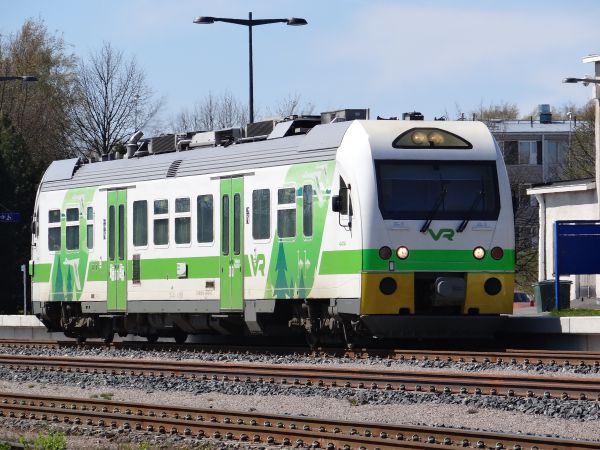
Finnish broad gauge diesel multiple units and railbuses.
This one is Czech built class Dm12 railbus at Hanko station in VR's new green and white livery. Picture
20.5.2015 by Ilkka Siissalo.
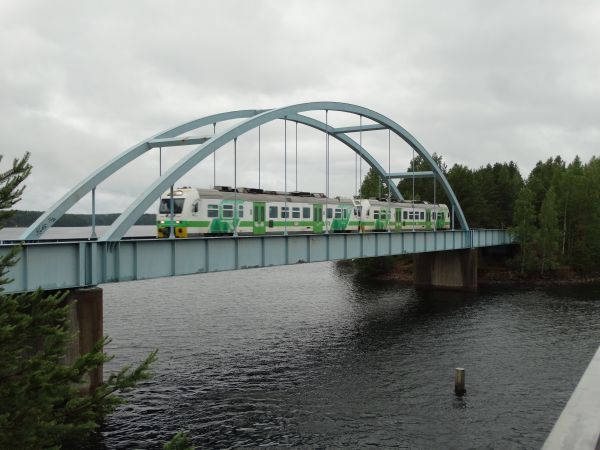
A train consisting of two class Dm12 railbuses on way from Savonlinna to Parikkala, here crossing the old steel bridge at
Punkaharju. Picture 12.7.2017 by Ilkka Siissalo.
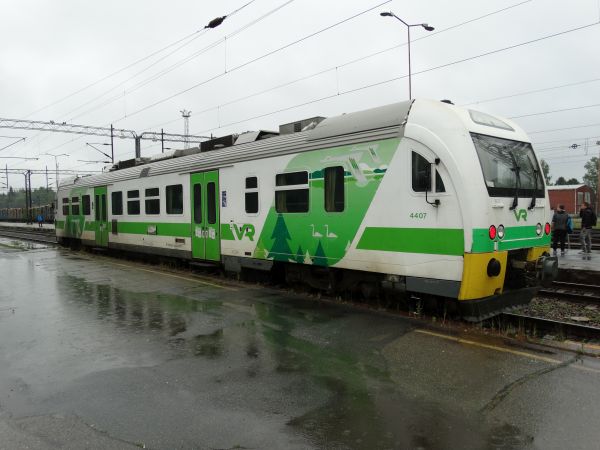
One class Dm12 railbus at Iisalmi station, ready to leave towards Ylivieska.
This same train was badly damaged in a car-train crash near Ylivieska only three days after this picture was taken.
Picture 12.7.2017 by Ilkka Siissalo.

A Dm9 series unit no. 5123 diesel commuter train "Porkkana" ("Carrot").
Photo by Kimmo Pyrhönen from the Keiturinsalmi bridge at Virrat 2.8.1992. This was the first time ever when a "carrot" train
was running on that railway line.
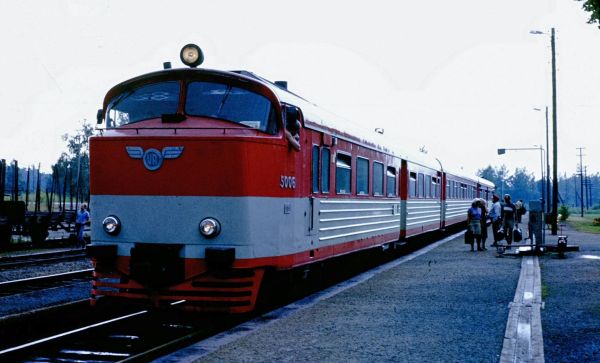
A class Dm8 diesel multiple unit "carrot" or "Porkkana" in Finnish. The classes Dm8 and Dm9
were almost similar, but Dm8 was designed for long routes and had fewer doors, while Dm9 was
thought to be used in regional traffic. In the end both types were used mixed mainly in long haul
traffic. They were built 1964-65. Top speed was 140 km/h and they had Italian Isotta Fraschini e
Motori Breda engines. Picture from Ähtäri station sometime in the early 1980s. Picture taken by Risto Vormala.
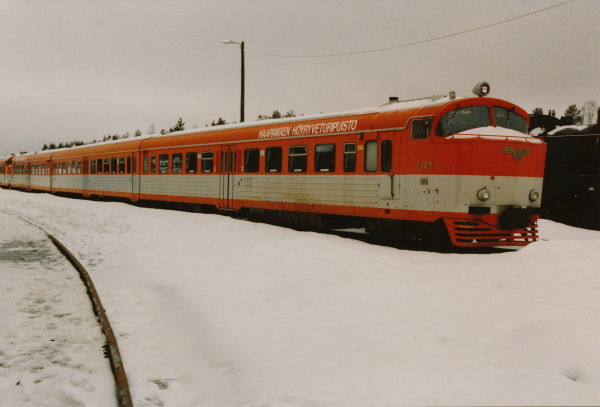
A good picture of a Dm9 "Carrot". The double doors reveal that this one was originally designed as a local or regional
train and therefore belongs to the series Dm9 instead of series Dm8. But like said already earlier, the two series
were almost identical and for much of their life they were used for the same trains.
Picture from Haapamäki steam park museum 4.4.1992 by Mikko Nyman.
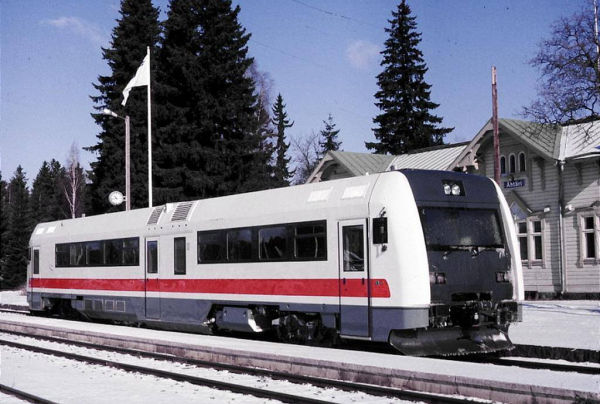
This picture is rare. Finnish VR decided to order new railbuses in 1995. There was a public tendering and as a result
VR ordered from Spain (from what was then GEC-Alsthom) 16 railbuses with an option of buying later 16 more. These were called
VR class Dm11. The first trains arrived in Finland in 1997 and they soon turned out to be miserable. Not only they weighed by far more
than was specified in the purchase agreement, but also they suffered from a multitude of serious problems. VR pulled all Dm11
trains out of service and initiated litigation against the builder of the trains. In 1999 all six units that had so far been
delivered to Finland were returned to builder, who later regauged them and sold them cheaply to Cuba. That didn't make them fine
trains though, and Cubans finally removed engines from them and used them as regular train coaches, but of course as such they are
extremely heavy. They were intended for up to 145 passengers and they weighed 46 tons, while the purchase agreement allowed
40 tons maximum. While they were still in Finland, they got the nickname "Mandolino", in reference to them being from Spain
and the fact that they had been ordered shortly after VR purchased Pendolino trains from Italy. This is a Dm11 "Mandolino"
at Ähtäri station some time in 1997 while they were still in trial service. Picture by Jorma Rauhala.
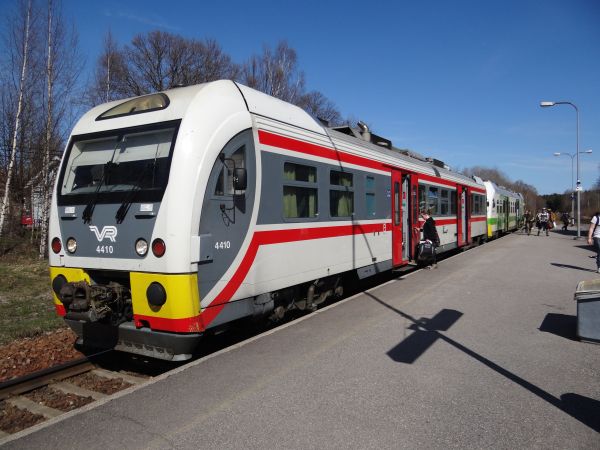
A similar Dm12 to the one at the top of this page, but here the first wagon is still in the original red-grey-white
livery. Here the second wagon is already in new colors. These Czech made railbuses were the later successors of the unlucky Dm11
"Mandolinos".
Picture from Tammisaari station 8.5.2013 by Ilkka Siissalo.
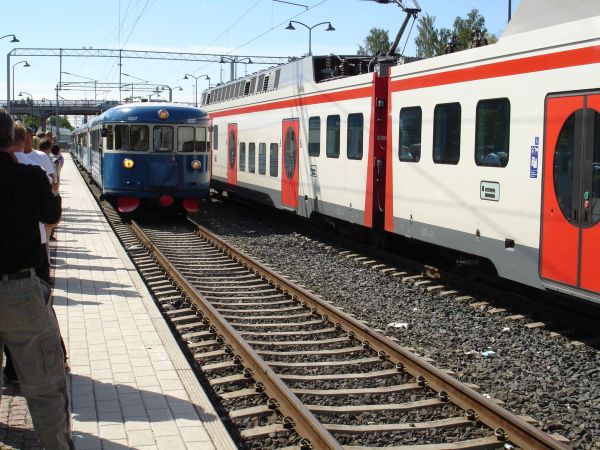
In the mid 1950s Finnish VR wanted to buy lightweight railcars to get rid of some of the old steam locomotive hauled
trains on less frequently used lines. Actually the intention was to buy German VT95 railbuses, which already received
the Finnish class number Dm5, but VR never got the permission to use so much foreign currency at a time when everything was
in short supply. The end result was to buy a license from Sweden to build modified copies of the Swedish Y6 railbuses.
These became in Finland the series Dm6 and later, after some further modifications (e.g. bigger wheels) Dm7. They soon got the
nickname "lättähattu" or "flat hat". They were used heavily until the 1980s. Here we see a museum train owned by PMR, the Museum
Railway Association of Porvoo, composed of Dm7
railcars and their unmotorised coaches approaching Kerava station. On the right a modern Sm4 electric multiple unit.
Photo from Kerava station 29.7.2006 by Ilkka Siissalo.
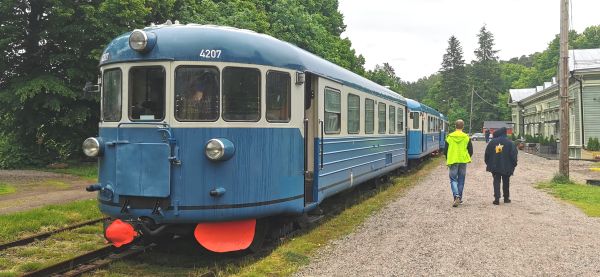
A museum railbus train of PMR, consisting of two class Dm7 diesel railbuses and one unmotorised coach in between them. This is
how these trains used to look like in the 1950s when they were new.
Picture from the station of Porvoo 18.6.2022 by Kari Wikström.
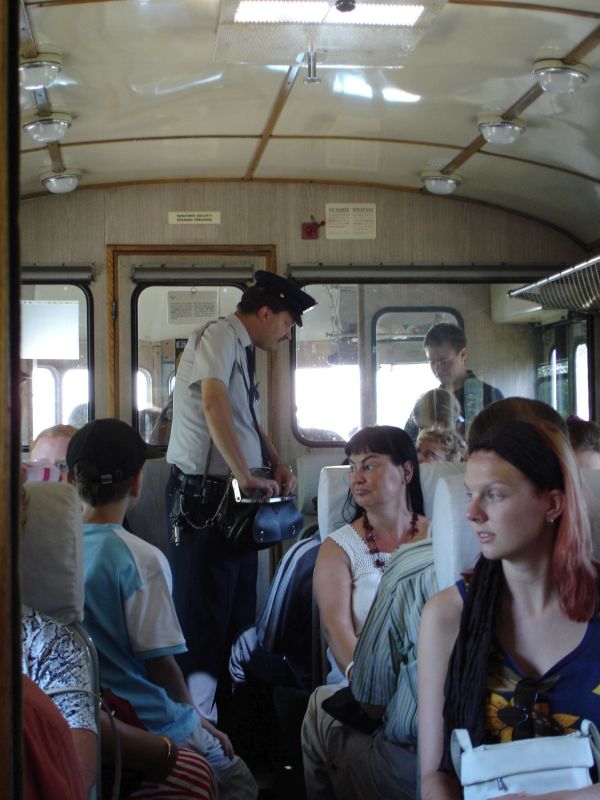
Inside a PMR Dm7 with a real 1970s feeling. The conductor wears a 1970s uniform and sells 1970s style tickets from a 1970s
style conductor's bag. Even all advertisements in the railcar are from that era.
Photo somewhere between Kerava and Porvoo stations 29.7.2006 by Ilkka Siissalo.
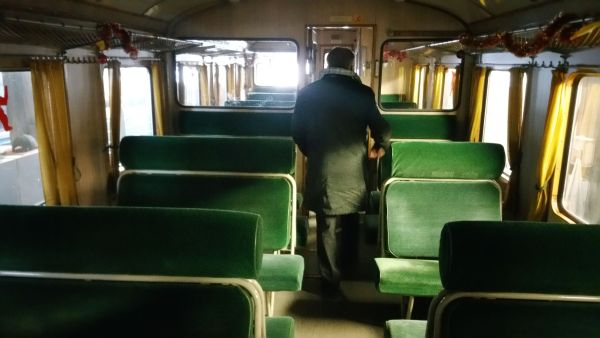
Another inside view of a Dm7 railbus, this time one that is owned by PoRha, railway hobbyists of Northern Finland.
Picture in Oulu 14.11.2016 by Ilkka Siissalo.
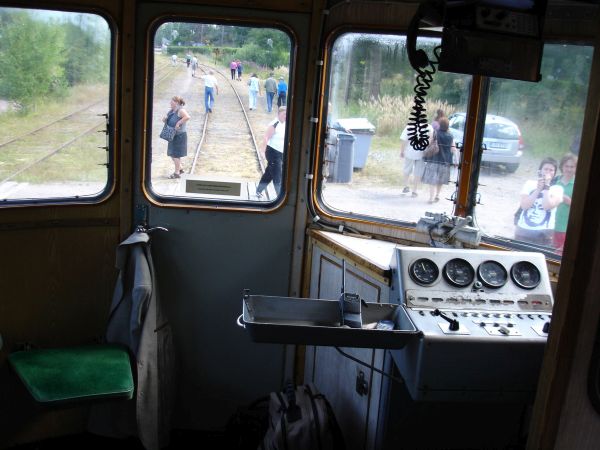
This is the driver's cab of a Dm7. Notice how a lockable lid can close the cab from unauthorised use when the wagon is used as a middle coach.
These railcars were relatively difficult to drive. They are diesels, but as in those days no electric remote control systems
existed, the remote controlling of several coupled motor coaches was done via pressurised air and the controls themselves were
quite unique in style. Picture from Porvoo station 29.7.2006 by Ilkka Siissalo.
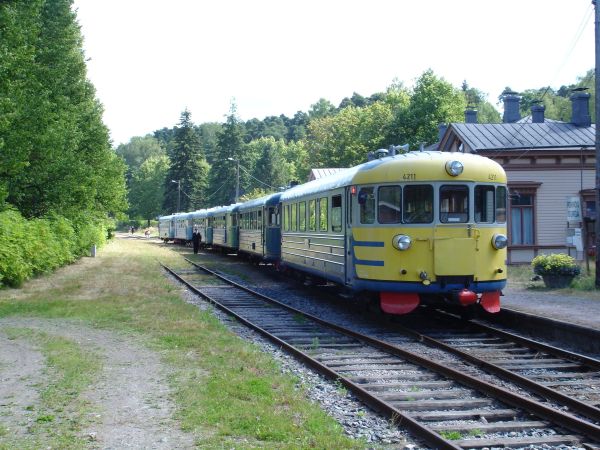
A long Dm7 "Lättähattu" (flat hat) train of PMR at the Porvoo station. All these units were originally blue and light grey, but a part of
them received in the 1980s a yellow front to better enable car drivers to notice an approaching train. Many people thought the yellow
ends were really ugly. The Dm6 and Dm7 railcars were produced by Valmet in the 1950s and the very last ones disappeared from VR's
commercial traffic in the late 1980s. However, altogether 20 Dm7 units and their unmotorised coaches have survived
thanks to several museum railroad associations. Picture from Porvoo station 29.7.2006 by Ilkka Siissalo.
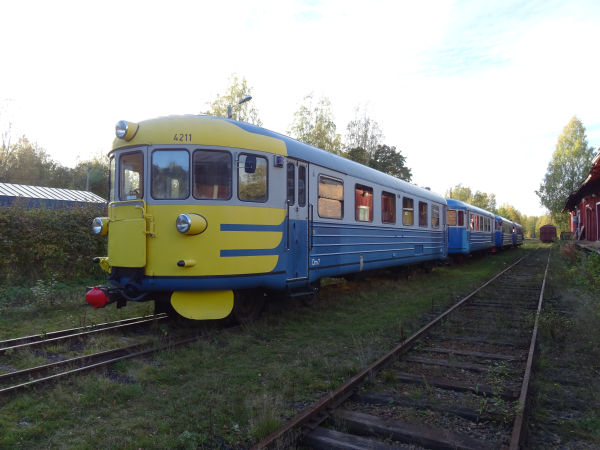
A four wagons long Dm7 "Lättähattu" (flat hat) historic train, consisting of Dm7 motorised wagons and one unmotorised bywagon.
The very ugly yellow paintings became common in the 1980s. They were intended to increase the visibility of an approaching train.
Picture from old Porvoo station 1.10.2018 by Ilkka Siissalo.
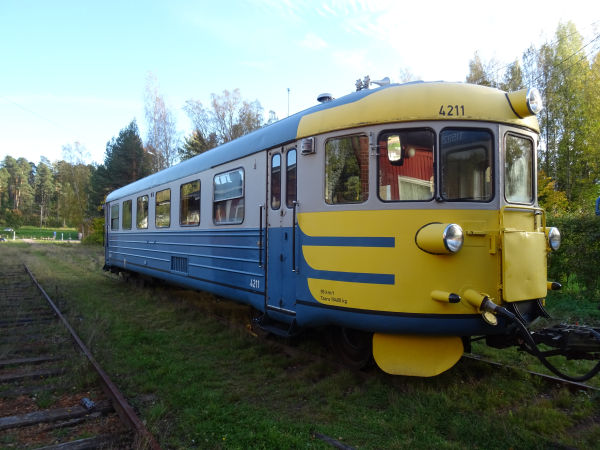
This is the same yellow-headed Dm7 unit as in the picture above, but seen from the other side.
Picture from old Porvoo station 1.10.2018 by Ilkka Siissalo.
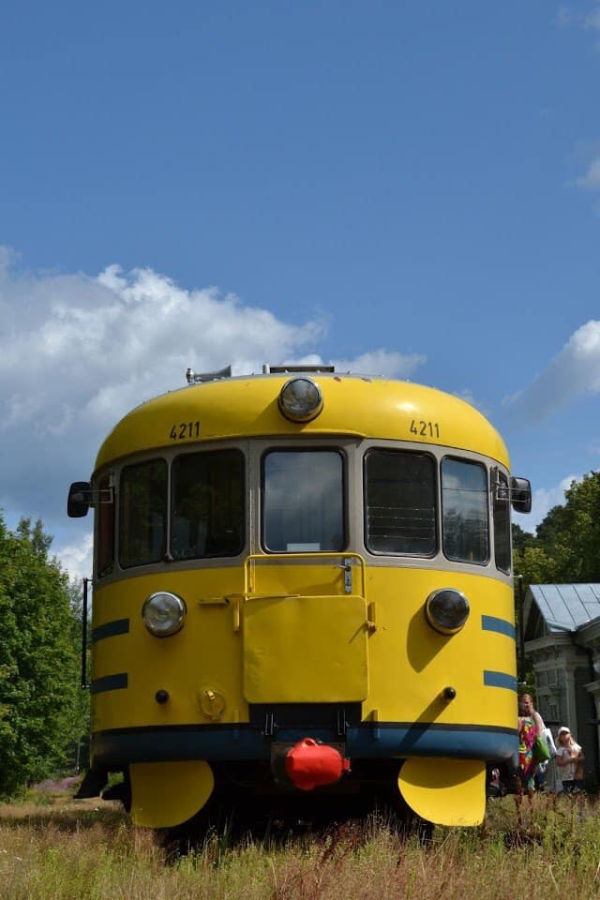
Front view of PMR's "Lättähattu" (flat hat) train.
Picture from Porvoo 20.7.2019 by Mirjam Heinonen.
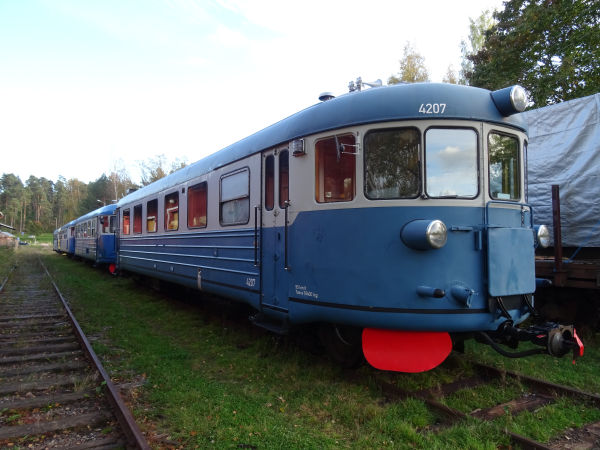
Same train as above, but seen from the other end.
Picture from old Porvoo station 1.10.2018 by Ilkka Siissalo.
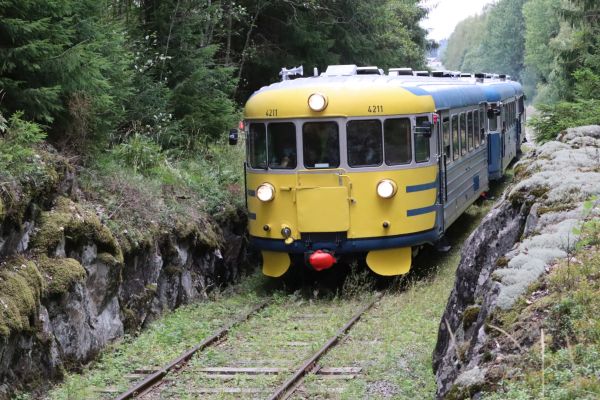
This is the same old Dm7 composition as shown above, but here it is underway between the old train stops of Haksi and Hinthaara,
running on the museum line towards Porvoo.
Picture from between Haksi and Hinthaara on the old Kerava to Porvoo museum train line, 7.8.2021 by Matti Heino.
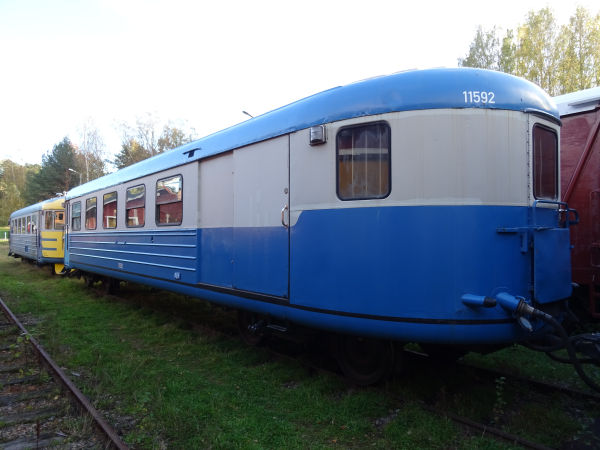
Unmotorised class EFiab wagon belonging to a Dm7 lättähattu train. About two thirds of the wagon are for passengers and
one end of the wagon is for cargo and for the conductor's working space.
Picture from old Porvoo station 1.10.2018 by Ilkka Siissalo.
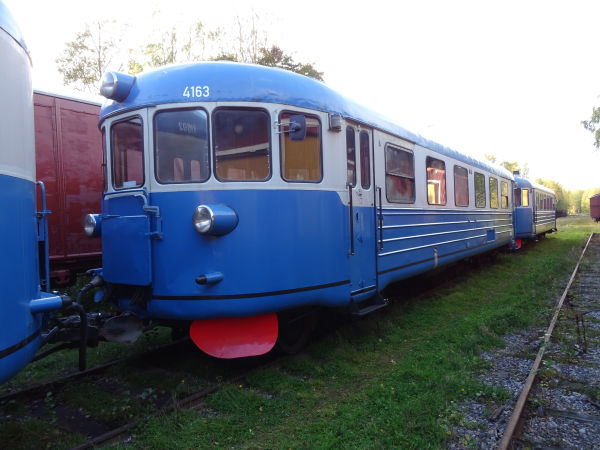
Two motorised class Dm7 railbus units belonging to the same train as above.
Picture from old Porvoo station 1.10.2018 by Ilkka Siissalo.
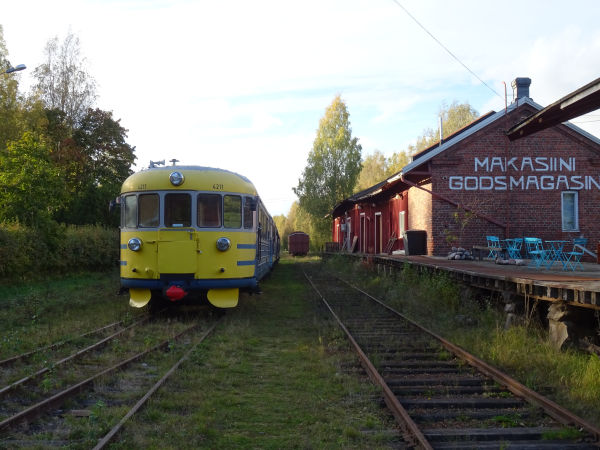
Just like in times long gone by. A historic Dm7 train at the very old cargo terminal of what used to be the station
of Porvoo. It looks like time has stopped somewhere in the 1980s.
Picture from old Porvoo station 1.10.2018 by Ilkka Siissalo.
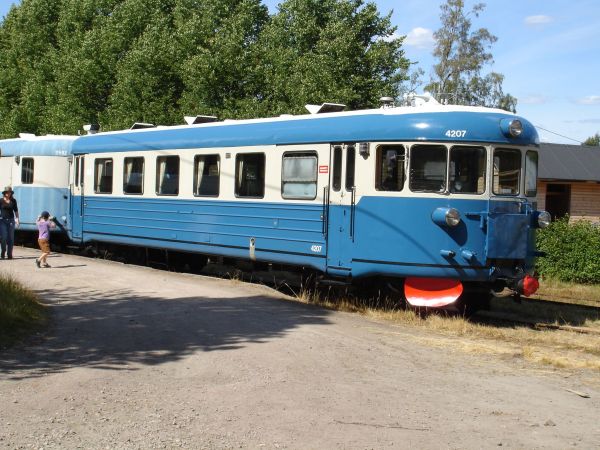
This is how the Dm7 railbuses looked like when they were new. Behind the motorised railbus you can also see a glimpse of an
unmotorised coach with a cargo department.
Picture from Porvoo station 29.7.2006 by Ilkka Siissalo.
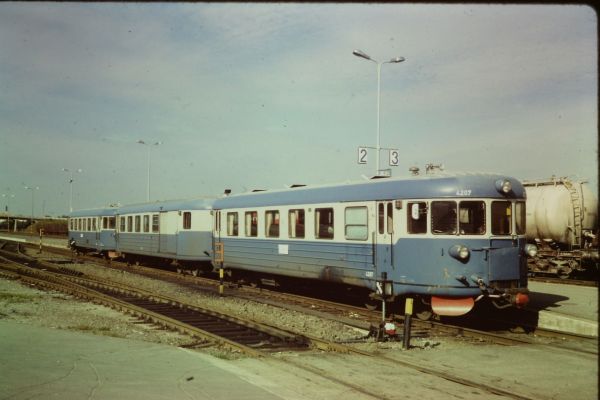
A picture from the "good old days": A railbus train consisting of two class Dm7 railbuses and one unmotorised class EFiab
coach has just arrived at the station of Kemi coming from Haaparanta on the Swedish side of the border. The bridge over
river Tornionjoki by the city of Tornio has double tracks so that trains of both Swedish normal gauge and Finnish broad
gauge can pass over the river. And in the old times Finnish trains like this one used to start from Haaparanta (Haparanda)
on the Swedish side.
Picture from Kemi in 1978 by Adrian Gray.
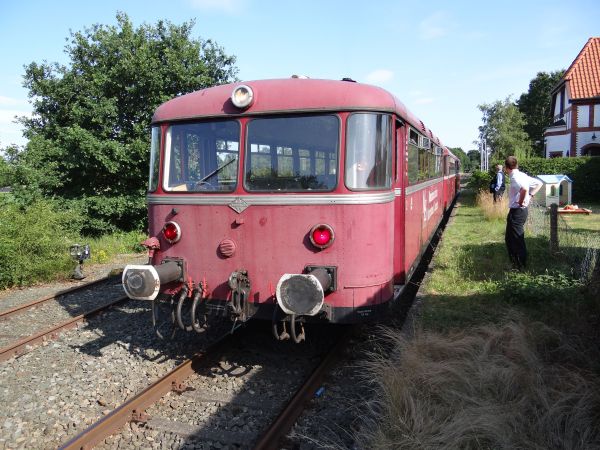
For comparison: This is what the Finnish VR originally would have wanted to buy but never got the permission, the German Uerdinger railbus VT95,
which in Finland would have been called Dm5 and would have received a blue and grey livery. Picture from the Museumseisenbahn
Ammerland-Saaterland e.V. association's museum railway 11.7.2015 by Ilkka Siissalo.

A Dm4 series unit no. 1617.
Diesel commuter train.
Built by Valmet in 1952.
Photo by Mikko Alameri.
Uploaded Feb 16, 1998

A diesel commuter train unit of the class Dm4, no. 1601 at Parikkala station in 1962.
Photo by Taisto Ketolainen.
Uploaded Feb 16, 1998

